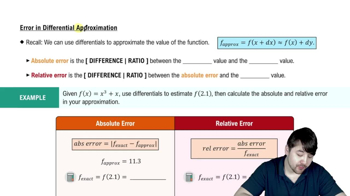Table of contents
- 0. Functions7h 52m
- Introduction to Functions16m
- Piecewise Functions10m
- Properties of Functions9m
- Common Functions1h 8m
- Transformations5m
- Combining Functions27m
- Exponent rules32m
- Exponential Functions28m
- Logarithmic Functions24m
- Properties of Logarithms34m
- Exponential & Logarithmic Equations35m
- Introduction to Trigonometric Functions38m
- Graphs of Trigonometric Functions44m
- Trigonometric Identities47m
- Inverse Trigonometric Functions48m
- 1. Limits and Continuity2h 2m
- 2. Intro to Derivatives1h 33m
- 3. Techniques of Differentiation3h 18m
- 4. Applications of Derivatives2h 38m
- 5. Graphical Applications of Derivatives6h 2m
- 6. Derivatives of Inverse, Exponential, & Logarithmic Functions2h 37m
- 7. Antiderivatives & Indefinite Integrals1h 26m
- 8. Definite Integrals4h 44m
- 9. Graphical Applications of Integrals2h 27m
- 10. Physics Applications of Integrals 2h 22m
4. Applications of Derivatives
Differentials
Problem 2.R.83
Textbook Question
b. Estimate a solution to the equation in the given interval using a root finder.
x=cos x; (0,π/2)
 Verified step by step guidance
Verified step by step guidance1
Identify the function for which we need to find the root. In this case, the function is f(x) = x - cos(x). We are looking for a value of x where f(x) = 0.
Choose a numerical method to estimate the root. A common method is the bisection method, which is suitable for continuous functions on a closed interval where the function changes sign.
Set the initial interval as given: [a, b] = [0, π/2]. Check the values of f(a) and f(b) to ensure that they have opposite signs, confirming that a root exists in the interval.
Apply the bisection method: Calculate the midpoint c = (a + b) / 2. Evaluate f(c). If f(c) is close to zero (within a desired tolerance), c is an approximate root. Otherwise, determine the subinterval [a, c] or [c, b] where the sign change occurs and repeat the process.
Continue iterating the bisection method, narrowing down the interval until the midpoint c is sufficiently close to the actual root, as determined by your tolerance level.
 Verified video answer for a similar problem:
Verified video answer for a similar problem:This video solution was recommended by our tutors as helpful for the problem above
Video duration:
4mPlay a video:
Was this helpful?
Key Concepts
Here are the essential concepts you must grasp in order to answer the question correctly.
Root Finding
Root finding is a numerical method used to determine the values of a variable that make a function equal to zero. In this context, we are looking for the value of x that satisfies the equation x = cos(x) within the interval (0, π/2). Common methods for root finding include the bisection method, Newton's method, and the secant method, each with its own advantages and limitations.
Recommended video:

Finding Limits by Direct Substitution
Fixed Point Iteration
Fixed point iteration is a technique used to find solutions to equations of the form x = g(x). In this case, we can rearrange the equation x = cos(x) to g(x) = cos(x). By iteratively substituting values into g(x), we can converge to a fixed point, which represents the solution to the original equation. This method is particularly useful when the function g(x) is continuous and the interval is chosen appropriately.
Recommended video:

Critical Points
Interval and Convergence
The interval (0, π/2) is crucial for ensuring that the root finding method converges to a solution. Within this interval, the function f(x) = x - cos(x) is continuous and changes sign, indicating the presence of a root according to the Intermediate Value Theorem. Understanding the behavior of the function within the specified interval helps in selecting the appropriate numerical method and ensuring that the iterations lead to a valid solution.
Recommended video:

Derivatives







